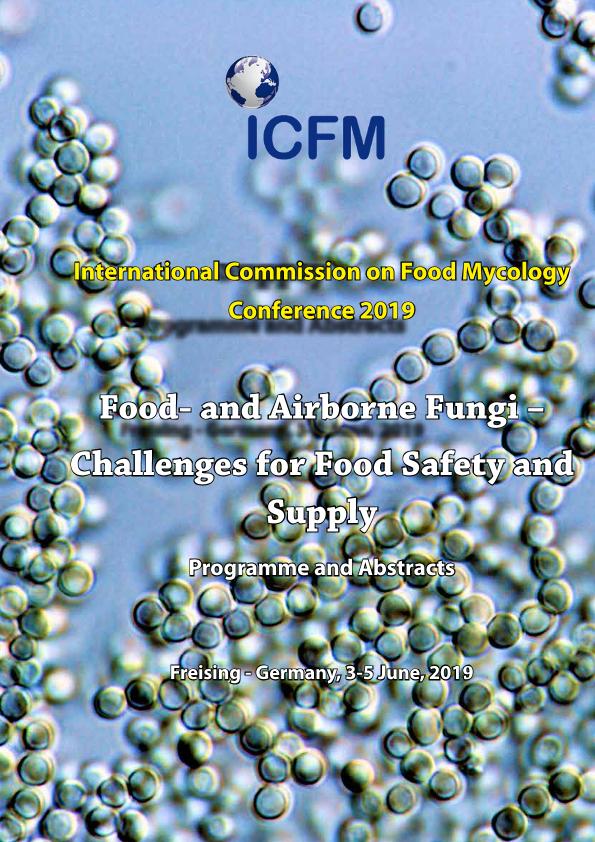Mostrar el registro sencillo del ítem
dc.contributor.author
Romero Donato, Cindy Johana

dc.contributor.author
Chulze, Sofia Noemi

dc.contributor.author
Ramirez, Maria Laura

dc.contributor.author
Sulyok, Michael

dc.date.available
2023-03-08T19:17:24Z
dc.date.issued
2019
dc.identifier.citation
Mycobiota and mycotoxin occurrence in chickpea produced in Argentina; International Commission on Food Mycology Conference; Freising; Alemania; 2019; 38-39
dc.identifier.uri
http://hdl.handle.net/11336/189992
dc.description.abstract
Chickpea (Cicer arietinum) is one of the most cultivated pulses in terms of world production. There is a high demand of this legume due to its nutritional value. Although it is more popular in developing countries, it is becoming recognized throughout the world. Chickpea is often attacked by fungi during pre and post-harvest stages, significantly affecting its productivity. Also some species can be potential mycotoxin producers that can lead to serious threats to human health. Since there is an increasing demand for high quality and innocuous foods, limits for mycotoxin contamination have been established. The aims of this survey were to determinate mycobiota and mycotoxin contamination in chickpea seed samples harvested from different chickpea growing areas in Argentina during the 2018 harvest season. All samples showed contamination with at least one fungal genus. In general, infection levels ranged from 10 to 100%. The most prevalent fungal genera isolated were Aspergillus and Alternaria. Other fungal genera isolated in less frequency were: Penicillium, Chaetomium, Rhizopus and Fusarium. Mycotoxin contamination was analyzed in 10 chickpea samples by LC-MS/MS. Although Fusarium was not the predominant fungal genus isolated, most detected mycotoxins werethose produced by members of this genus. As a result, deoxynivalenol, zearalenone, beauvericin and alternariol monomethyl ether were detected in all samples, in levels ranging from 26.1 - 626.2 ng/g, 1.71 ? 227.1 ng/g, 7.5 ? 73.7 ng/g and 0.7 ? 14.5 ng/g, respectively. In 40% of analyzed samples, 3-acetyldeoxynivalenol was found in levels ranging from 12.7 - 50.744 ng/g. Alternariol was detected in 30% of samples in levels ranging from 1.4 - 2.3 ng/g. Only one sample was contaminated with fumonisins (16.4 ng/g and 15.3 ng/g for FB1 and FB2, respectively). Another sample was contaminated with 20.5 ng/g of 15- acetyldeoxynivalenol. The occurrence of Fusarium mycotoxins at harvest time could indicate that Fusarium contamination occurs under field conditions during grain development,when high water activity levels are observed.
dc.format
application/pdf
dc.language.iso
eng
dc.publisher
International Commission on Food Mycology
dc.rights
info:eu-repo/semantics/openAccess
dc.rights.uri
https://creativecommons.org/licenses/by-nc-sa/2.5/ar/
dc.subject
MYCOTOXIN
dc.subject
MYCOBIOTA
dc.subject
CHICKPEA
dc.subject.classification
Agricultura

dc.subject.classification
Agricultura, Silvicultura y Pesca

dc.subject.classification
CIENCIAS AGRÍCOLAS

dc.title
Mycobiota and mycotoxin occurrence in chickpea produced in Argentina
dc.type
info:eu-repo/semantics/publishedVersion
dc.type
info:eu-repo/semantics/conferenceObject
dc.type
info:ar-repo/semantics/documento de conferencia
dc.date.updated
2023-03-07T12:34:21Z
dc.journal.pagination
38-39
dc.journal.pais
Alemania

dc.journal.ciudad
Freising
dc.description.fil
Fil: Romero Donato, Cindy Johana. Universidad Nacional de Río Cuarto. Facultad de Ciencias Exactas Fisicoquímicas y Naturales. Instituto de Investigación en Micología y Micotoxicología. - Consejo Nacional de Investigaciones Científicas y Técnicas. Centro Científico Tecnológico Conicet - Córdoba. Instituto de Investigación en Micología y Micotoxicología; Argentina
dc.description.fil
Fil: Chulze, Sofia Noemi. Universidad Nacional de Río Cuarto. Facultad de Ciencias Exactas Fisicoquímicas y Naturales. Instituto de Investigación en Micología y Micotoxicología. - Consejo Nacional de Investigaciones Científicas y Técnicas. Centro Científico Tecnológico Conicet - Córdoba. Instituto de Investigación en Micología y Micotoxicología; Argentina
dc.description.fil
Fil: Ramirez, Maria Laura. Universidad Nacional de Río Cuarto. Facultad de Ciencias Exactas Fisicoquímicas y Naturales. Instituto de Investigación en Micología y Micotoxicología. - Consejo Nacional de Investigaciones Científicas y Técnicas. Centro Científico Tecnológico Conicet - Córdoba. Instituto de Investigación en Micología y Micotoxicología; Argentina
dc.description.fil
Fil: Sulyok, Michael. University of Natural Resources and Life Sciences; Austria
dc.relation.alternativeid
info:eu-repo/semantics/altIdentifier/url/https://www.foodmycology.org/images/download/ABSTRACT_BOOK_ICFM_2019.pdf
dc.conicet.rol
Autor

dc.conicet.rol
Autor

dc.conicet.rol
Autor

dc.conicet.rol
Autor

dc.coverage
Internacional
dc.type.subtype
Conferencia
dc.description.nombreEvento
International Commission on Food Mycology Conference
dc.date.evento
2019-06-03
dc.description.ciudadEvento
Freising
dc.description.paisEvento
Alemania

dc.type.publicacion
Book
dc.description.institucionOrganizadora
International Commission on Food Mycology
dc.source.libro
International Commission on Food Mycology Conference 2019: Food- and Airborne Fungi Challenges for Food Safety and Supply
dc.date.eventoHasta
2019-06-05
dc.type
Conferencia
Archivos asociados
